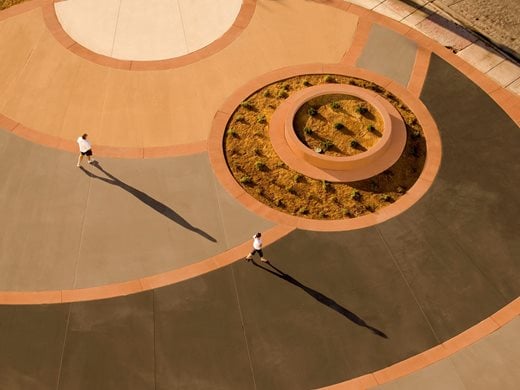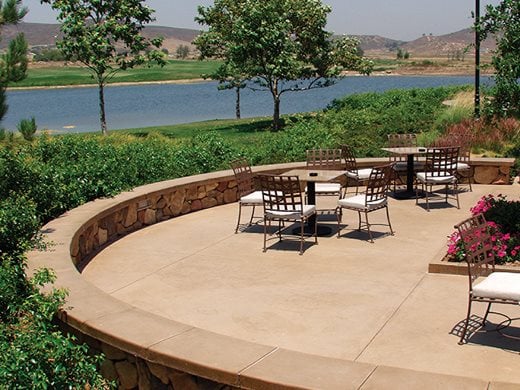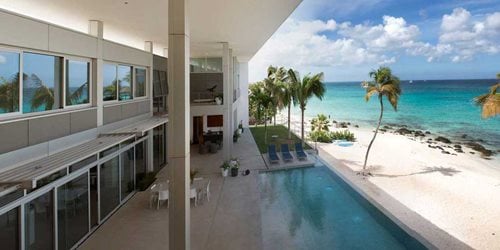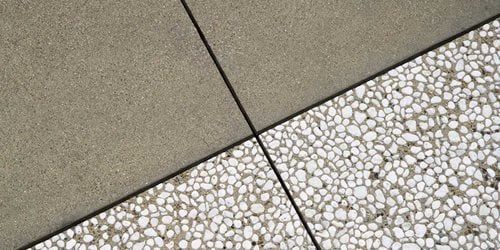Everything you need to know about adding color to concrete—from selection to installation and maintenance
Coloring concrete is a fantastic way to add visual interest to both residential and commercial spaces. Because of the wide range of colors available, you can color a concrete surface to fit the style of any space—whether you want a subtle and serene, vibrant and fun, or something in between.


Yes. Colored concrete is just as durable and strong as traditional concrete, and it also adds aesthetic value. When you use high-quality products, the color will remain for many years, as the pigments are UV-resistant and won't fade easily, reducing the need for frequent maintenance or refinishing.
When done right, colored concrete can coordinate seamlessly with surrounding landscapes or architecture, providing a cohesive, custom look that adds value to any property.
There are several ways to color concrete, and the method you choose depends on what look you’re going for. Each can be used to achieve a range of colors, textures, and finishes, allowing for custom designs.
The right color for your surface really depends on the look you’re going for and the style of the surrounding space. At Solomon Colors we have a wide range of colors to choose from.
Some color categories tend to be most popular, as they tend to work in a variety of spaces:
Here are just a few examples of what's possible when coloring concrete:
Yes, colors can be combined to create a custom appearance. Combining colors can help create effects. When creating the look of natural stone, for example, combining colors is a great way to achieve a more realistic look. See Brickform’s guide to choosing colors for stamped concrete for more on this topic.
Yes, colored concrete can be used in combination with other decorative finishes such as stamping, exposed aggregate, broom finish, and more. Contractors have used our colors with other techniques to create the look of natural stone, tile, or even wood. Our versatile color options allow for endless design possibilities to enhance the visual appeal of outdoor patios, driveways, porches, interior floors, and more.
While color samples provide a good indication of your concrete's final appearance, they don't account for all variables that can influence the outcome. Consider these factors when planning your integrally colored concrete project:
Pro Tip: Make sure the ready-mix producer and contractor are using the same color cards to prevent miscommunications in color choices.


Though colored decorative concrete is durable, it does need to be properly cared for, just like standard concrete, to extend its appearance.
Yes. If you want to extend the life of your colored decorative concrete surface, you need to seal it. Sealers protect a concrete surface against staining, water damage, and abrasion. On top of all that, it can even enhance the appearance of your surface. Brickform’s high-performing sealers also protect the finish from UV damage, yellowing, scuffing, and wear-and-tear.
In addition to sealing the surface, regular maintenance is key to preserving the color quality and surface condition. Here are other steps you should take to maintain a colored concrete surface:
Pro Tip: If you’re not sure if the sealer is still functioning properly, pour some water on the concrete. If you notice the water beads up, the sealer is still working. If the water soaks into the surface, that’s a sign that it’s time to apply sealer again.
Colored concrete can last for decades or more. Its longevity is comparable to traditional gray concrete, as it retains the same durability and structural integrity. Factors such as the quality of the installation, the type of pigments or dyes used, environmental exposure, and maintenance practices can influence its lifespan. Regular cleaning, sealing, and protecting the surface from heavy impacts or harsh chemicals will help preserve the color and extend the life of the decorative concrete.
When concrete is colored using high-quality products, and maintained well, the color shouldn’t fade. In fact, when using Solomon Colors’ integral coloring system, the color of your concrete will not fade or wash out over time due to the UV-stable iron oxide pigments. (However, keep in mind that some darker pigments, such as carbon black, may fade over time in certain conditions.)
Yes, if you have an existing concrete surface, you can add color using stains or dyes. Using integral color or color hardeners is only for new concrete pours.
We recommend browsing pictures online and color charts to get inspiration and help narrow down what you do and don’t like.
Here are some things you might want to consider when choosing a color:

Cool concrete isn't just neat. It's literally cool! Who hasn't had the experience of sprinting over a scorching hot concrete pool deck?

Learn the basics of coloring exposed aggregate and get helpful tips so you can get the most out of your project

When color doesn’t match, especially when the mismatched slabs are side by side, panic often sets in.
Explore impressive concrete installations to find inspiration for your next project.
Find out how much color and fiber you'll need for any size project.